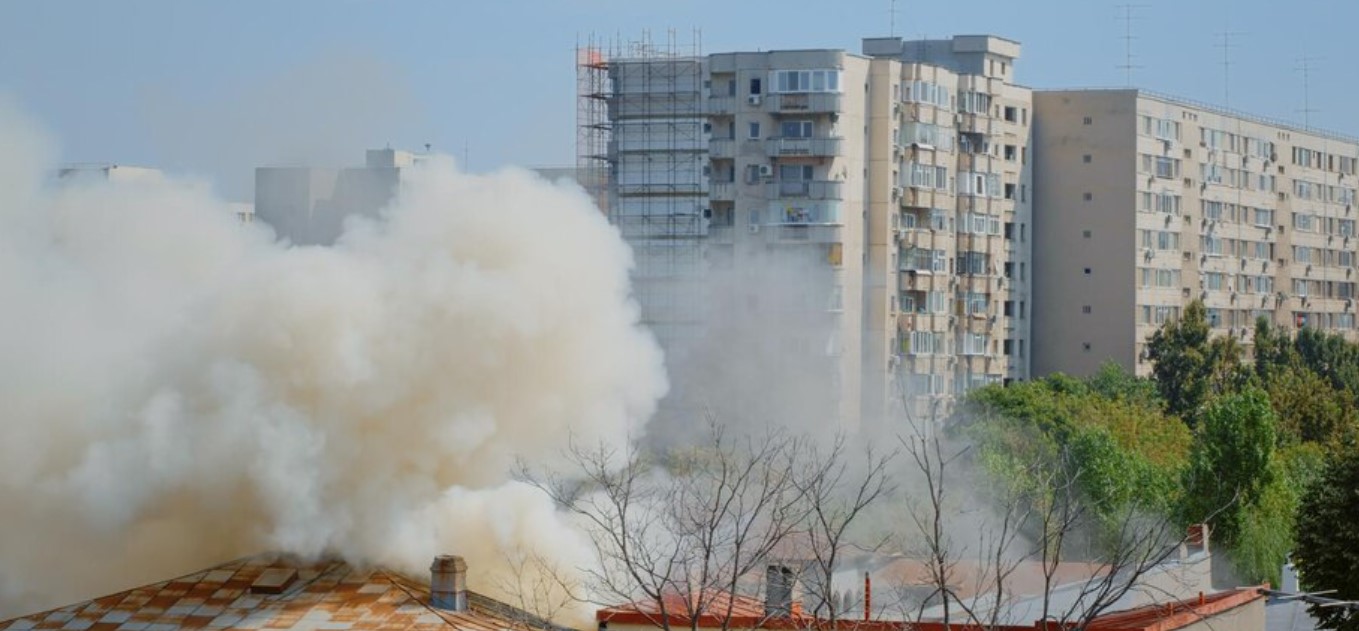Fire can be devastating, especially in buildings with hazardous materials like asbestos. It’s not just the flames that pose a threat; the materials inside the building can make a bad situation worse.
Asbestos, a once-popular building material known for its fire-resistant properties, presents unique risks when involved in a fire. This blog explores what happens when buildings containing asbestos catch fires and what can be done to prevent exposure to asbestos in such cases.
What is Asbestos?
Asbestos is a naturally occurring mineral. It comprises fine, durable fibres resistant to heat, fire and many chemicals. Because of these properties, asbestos was widely used in construction materials, including insulation, roofing and flooring.
However, it was later discovered that asbestos exposure can lead to serious health issues, including asbestosis, mesothelioma and lung cancer. As a result, asbestos was banned in many countries, but it still poses a risk as it is present in older buildings.
Health Risks of Asbestos Exposure
Asbestos fibres are tiny but mighty in their potential to cause harm. When asbestos-containing materials are disturbed, they release these fibres into the air. Inhaling these fibres can lead to serious health issues, including:
- Asbestosis: A chronic lung disease that causes a wound in the lung tissue, leading to difficulty in breathing and reduced lung function over time.
- Lung Cancer: Asbestos exposure can increase the risk of lung cancer, often appearing decades after the initial exposure.
- Mesothelioma: A unique and aggressive cancer that affects the lining of the lungs, abdomen and heart.
- Other Cancers: Asbestos exposure is also linked to cancers of the larynx, ovary and other organs.
What Happens to a Building with Asbestos During a Fire?
When a building containing asbestos catches fire, the situation can become extremely hazardous. Here’s a breakdown of the process:
Heat and Flames
The intense fumes and heat from the fire can cause asbestos-containing materials to break down. Although asbestos is fire-resistant, prolonged exposure to high temperatures can compromise its integrity. This breakdown can lead to the crumbling and fragmentation of asbestos materials, setting the stage for further hazards.
Release of Fibers
As the materials degrade under the heat, asbestos fibres can be released into the air. This release is more pronounced when materials are directly exposed to flames, causing them to crack and crumble. Once airborne, these fibres become a significant inhalation hazard for anyone in or near the building, increasing the risk of asbestos-related diseases.
Smoke Spread
The smoke from the fire can carry asbestos fibres over long distances. This dispersion can lead to contamination of not just the building itself but also nearby areas. Wind and ventilation systems can further spread these fibres, potentially affecting neighbouring buildings and outdoor environments, making the contamination widespread and challenging to control.
Post-Fire Hazards
Even after the fire is extinguished, the danger isn’t over. The debris left behind can still contain harmful asbestos fibres, posing a risk during cleanup and demolition. Without proper handling and disposal, these fibres can become airborne again, putting cleanup crews and others at risk of exposure and prolonging the health hazard long after the flames have been put out.
Asbestos Risks During a Fire
The primary concern during a fire is the release of asbestos fibres into the air. Anyone in or near the burning building, including firefighters, residents and bystanders, can inhale these fibres. The chaotic environment of fire makes it difficult to control the spread of these fibres. The risk isn’t confined to the duration of the fire. The cleanup process can stir up asbestos fibres post-fire, prolonging the danger.
Immediate Risks
- Inhalation: People nearby can breathe in asbestos fibres, which are invisible to the naked eye and can penetrate deep into the lungs, causing immediate and long-term health issues.
- Contamination: Firefighters’ gear and equipment can become contaminated with asbestos fibres, turning their protective gear into a potential source of exposure even after the fire has been extinguished.
- Spread: Smoke can carry fibres to surrounding areas, contaminating nearby buildings and outdoor spaces and potentially exposing more people to the hazardous fibres.
Long-term Risks
- Cleanup: Improper handling during cleanup can release more fibres into the air. Without specialised training and equipment, those involved in the cleanup process can inadvertently exacerbate the contamination.
- Health Issues: Long-term health problems from inhaling fibres include chronic respiratory diseases, lung cancer, and mesothelioma, which may not manifest until many years after exposure, making early diagnosis and treatment challenging.
How to Protect Individuals From Asbestos Exposure
Protection from asbestos exposure during and after a fire requires careful planning and execution. Here are some essential strategies:
Firefighter Gear: Ensure firefighters wear proper protective gear, including respirators, to shield them from inhaling asbestos fibres. This gear should be regularly checked and maintained to ensure maximum protection.
Evacuation: Quickly evacuate anyone from the vicinity of the fire. Establish clear evacuation routes and ensure all building occupants know these routes to minimise exposure to asbestos-laden smoke and debris.
Fire Safety Training: Building occupants and staff should undergo fire safety training. It teaches them fire prevention strategies, evacuation procedures and how to use extinguishers for small fires.
Professional Cleanup: Hire professionals trained in asbestos abatement to handle the cleanup. These experts have the equipment and knowledge to remove and dispose of asbestos-containing materials safely, ensuring minimal fibre release.
Safety Zones: Establish zones around the affected area to keep people away. Mark these zones and restrict access until the area is deemed safe through thorough testing and inspection.
Air Monitoring: Conduct air quality tests to monitor asbestos levels. Continuous air monitoring ensures that asbestos fibres are not present during and after cleanup, protecting workers and nearby residents from exposure.
UKATA Asbestos Awareness Training: Provide UKATA asbestos awareness training to individuals who may be at risk of exposure. The training educates them on the likely locations of asbestos, the associated health risks, safety precautions and appropriate actions to take in case of accidental exposure.
Regulatory Framework and Guidelines
Dealing with asbestos is heavily regulated to protect public health. In the UK, the Control of Asbestos Regulations 2012 mandates building owners to identify and assess asbestos presence, manage and minimise exposure risks and ensure worker training.
Key provisions include conducting asbestos surveys, assessing risks and developing management plans. Specific asbestos-related work must be performed by licensed contractors, and authorities must be notified before any work begins.
Adhering to these regulations is essential to avoid severe penalties and ensure the safety of all individuals at risk of asbestos exposure.
Conclusion
Fire in a building with asbestos is hazardous due to the release of dangerous fibres. While asbestos is fire-resistant, its fibres pose severe health risks when exposed to heat. Proper protective gear, professional cleanup and adherence to regulations are crucial for managing this risk. The Control of Asbestos Regulations 2012 provides essential guidelines to minimise dangers and protect public health. The risks associated with asbestos in fires can be effectively managed by staying informed and prepared.










